The Intel Core i3-13100F Review: Finding Value in Intel's Cheapest Core Chip
by Gavin Bonshor on April 20, 2023 9:00 AM ESTCPU Benchmark Performance: Simulation
Simulation and Science have a lot of overlap in the benchmarking world. The benchmarks that fall under Science have a distinct use for the data they output – in our Simulation section, these act more like synthetics but at some level are still trying to simulate a given environment.
In the encrypt/decrypt scenario, how data is transferred and by what mechanism is pertinent to on-the-fly encryption of sensitive data - a process by which more modern devices are leaning to for software security.
We are using DDR5-4800 memory on the Intel Core i3-13100F as per the JEDEC specifications. Other recent chips, such as Intel's 13th/12th Gen Core series and Ryzen 7000 processors, are also tested at the rated JEDEC specifications. We tested the aforementioned platforms with the following settings:
- DDR5-5600B CL46 - Intel 13th Gen
- DDR5-5200 CL44 - Ryzen 7000
- DDR5-4800 (B) CL40 - Intel 12th Gen
- DDR5-4800 (B) CL40 - Intel 13th Gen Core i3 series
All other CPUs such as Ryzen 5000 and 3000 were tested at the relevant JEDEC settings as per the processor's individual memory support with DDR4.
Simulation
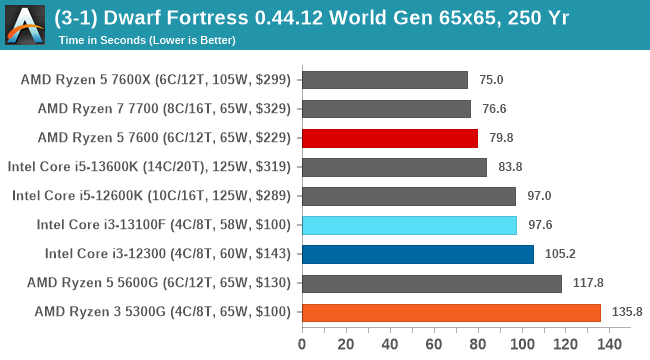


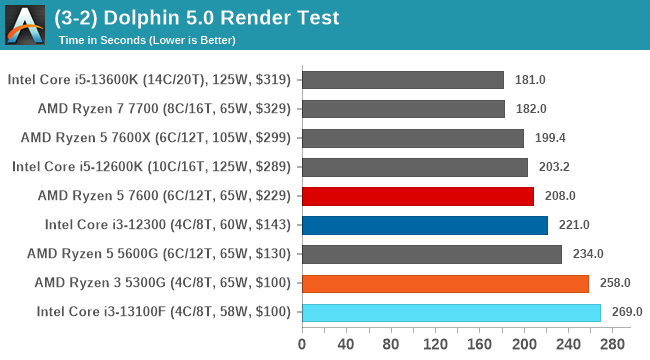
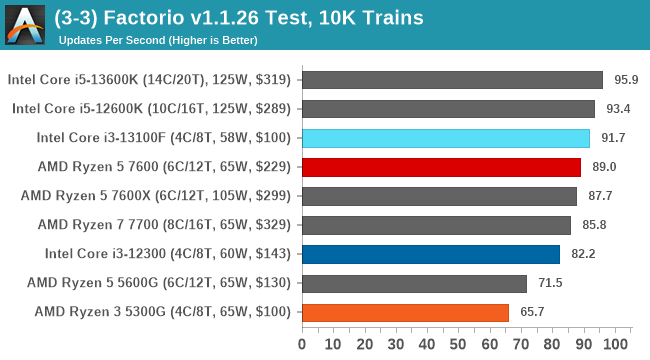
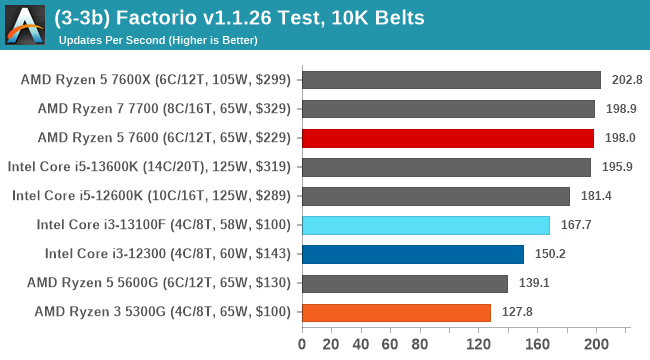
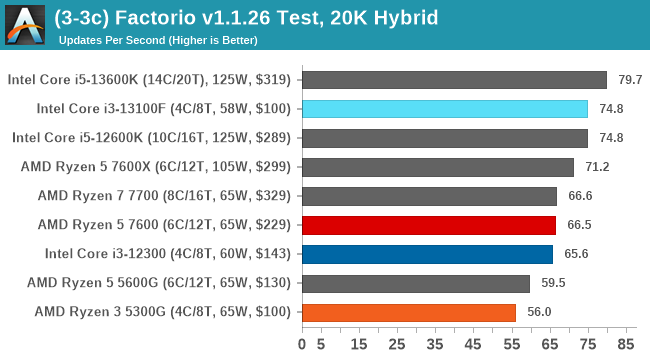
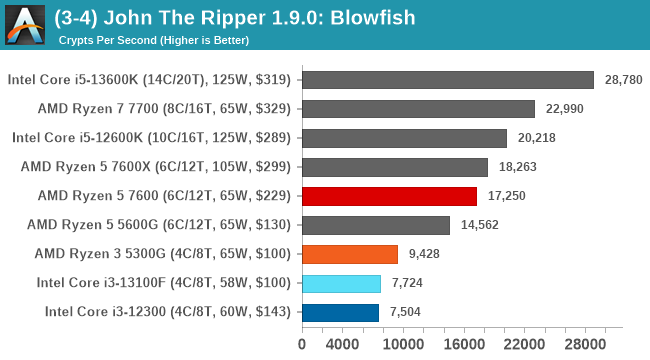

In our simulation-based tests, the Core i3-13100F lacks the grunt of the other chips simply because it only has four cores. The Core i3-13100F did, however, perform much better than expected in some of our Dwarf Fortress and Factorio benchmarks. It should be noted that it's apparent that in simulations, chips with a higher core count, higher IPC performance, and faster turbo clock speeds typically benefit users better that are doing compute heavy workloads.










34 Comments
View All Comments
porina - Thursday, April 20, 2023 - link
"Kaby Lake family of parts (8th Gen Core)" 8th gen was Coffee Lake.Interesting overall. I'd consider 6 core as entry level for anything other than the most basic tasks and 8 isn't that much a stretch.
Ryan Smith - Thursday, April 20, 2023 - link
Ahh, you're right. We got Kaby, and then Coffee, and then Coffee again. Thanks!adamxpeter - Thursday, April 20, 2023 - link
"but for an MSRP of $109 and a current selling price of $100 at Amazon" - then why $119 on the diagrams?Gavin Bonshor - Friday, April 21, 2023 - link
Thank you for pointing this out. I've changed it. When I made the graphs, that was the price, and I just forgot to update it.nrencoret - Thursday, April 20, 2023 - link
Although I like the article, I think the value comes in the form of the 5600g. I think the author should have focused attention not on the R7 but on the 5600. 20/30 USD for a more complete package seems to me like a better price/performance competitor.dwillmore - Friday, April 21, 2023 - link
That was my takeaway as well. It seemed odd to pick the F version of the 13th gen chip when everything else in the price segment had graphics. It seems an unfair bias against all of the other chips.If I was looking at a machine in this range, I'd certainly look at the 5600G. Fortunately, I am not, I just retired a 3700X to my kids PC.
lightningz71 - Thursday, April 20, 2023 - link
Why, oh why, are we pitting a 13100F against the 5300g? If you are dredging the bottom of the barrel, you need to look at the Ryzen 5500, which is going for $96 at amazon right now. It has NO video, matching the 13100f, has TWO more cores, and a higher boost than the 5300g. The two additional cores significantly extend it's useful life and opens higher end, more modern games to the user. It can go on any of the AM4 boards easily as well. In addition, having TWICE the L3 cache of the 5300g makes a notable impact on many titles. Yes, I doubt it wins in single threaded benchmarks, but in practicle use, its likely an overall netter choice!Ryan Smith - Friday, April 21, 2023 - link
Picking the competition for low-end chips is always a bit of a challenge due to the sheer number of options. There's the last-gen stuff, the current-gen stuff, the higher-tier last-gen stuff that's had price cuts, random SKUs that may or may not have received permanent price cuts, etc. And of course, what chips we have on hand, since AMD and Intel don't sample their complete product stacks.We opted to focus on the true low-end parts, in part because that's what we have available, and because I'm not convinced a $99 chiplet Ryzen is going to hang around. But you're definitely correct that there are additional comparisons we could have made.
DirtyLoad - Wednesday, April 26, 2023 - link
Hi Ryan,I like the article, but the better chip to compare is the 5600. It has double the L3 of the 5600g, which is just a 5500 with graphics. Wouldn't the extra cache help on some games/programs.
Samus - Sunday, April 23, 2023 - link
I would argue the 'practical' use these budget chips target greatly benefit from stronger, not more cores, and Intel wins that department when comparing Zen3 Ryzen 5xxx parts to 12\13 gen.